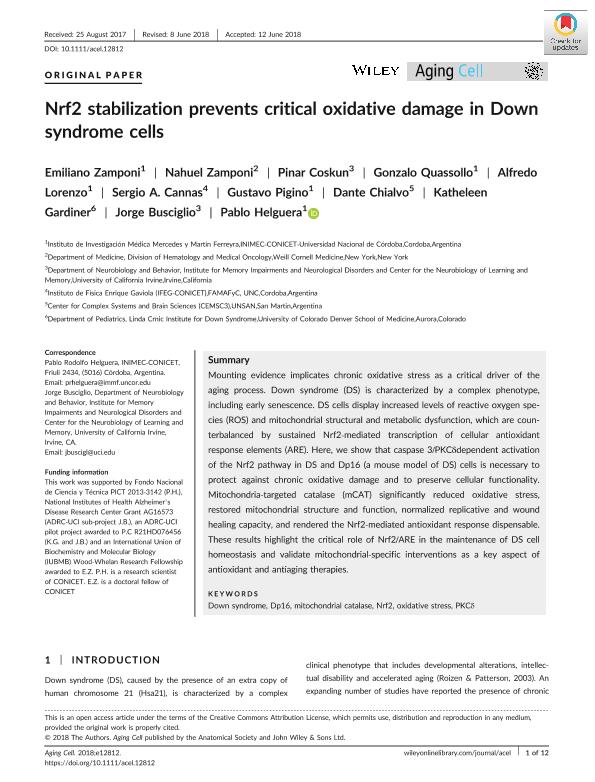Artículo
Nrf2 stabilization prevents critical oxidative damage in Down syndrome cells
Zamponi, Emiliano ; Zamponi, Nahuel
; Zamponi, Nahuel ; Coskun, Pinar; Quassollo Infanzon, Gonzalo Emiliano
; Coskun, Pinar; Quassollo Infanzon, Gonzalo Emiliano ; Lorenzo, Alfredo Guillermo
; Lorenzo, Alfredo Guillermo ; Cannas, Sergio Alejandro
; Cannas, Sergio Alejandro ; Pigino, Gustavo Fernando
; Pigino, Gustavo Fernando ; Chialvo, Dante Renato
; Chialvo, Dante Renato ; Gardiner, Katheleen; Busciglio, Jorge; Helguera, Pablo Rodolfo
; Gardiner, Katheleen; Busciglio, Jorge; Helguera, Pablo Rodolfo
 ; Zamponi, Nahuel
; Zamponi, Nahuel ; Coskun, Pinar; Quassollo Infanzon, Gonzalo Emiliano
; Coskun, Pinar; Quassollo Infanzon, Gonzalo Emiliano ; Lorenzo, Alfredo Guillermo
; Lorenzo, Alfredo Guillermo ; Cannas, Sergio Alejandro
; Cannas, Sergio Alejandro ; Pigino, Gustavo Fernando
; Pigino, Gustavo Fernando ; Chialvo, Dante Renato
; Chialvo, Dante Renato ; Gardiner, Katheleen; Busciglio, Jorge; Helguera, Pablo Rodolfo
; Gardiner, Katheleen; Busciglio, Jorge; Helguera, Pablo Rodolfo
Fecha de publicación:
10/2018
Editorial:
Wiley Blackwell Publishing, Inc
Revista:
Aging Cell
ISSN:
1474-9718
Idioma:
Inglés
Tipo de recurso:
Artículo publicado
Clasificación temática:
Resumen
Mounting evidence implicates chronic oxidative stress as a critical driver of the aging process. Down syndrome (DS) is characterized by a complex phenotype, including early senescence. DS cells display increased levels of reactive oxygen species (ROS) and mitochondrial structural and metabolic dysfunction, which are counterbalanced by sustained Nrf2-mediated transcription of cellular antioxidant response elements (ARE). Here, we show that caspase 3/PKCδdependent activation of the Nrf2 pathway in DS and Dp16 (a mouse model of DS) cells is necessary to protect against chronic oxidative damage and to preserve cellular functionality. Mitochondria-targeted catalase (mCAT) significantly reduced oxidative stress, restored mitochondrial structure and function, normalized replicative and wound healing capacity, and rendered the Nrf2-mediated antioxidant response dispensable. These results highlight the critical role of Nrf2/ARE in the maintenance of DS cell homeostasis and validate mitochondrial-specific interventions as a key aspect of antioxidant and antiaging therapies.
Palabras clave:
DOWN SYNDROME
,
DP16
,
MITOCHONDRIAL CATALASE
,
NRF2
,
OXIDATIVE STRESS
,
PKC-Delta
Archivos asociados
Licencia
Identificadores
Colecciones
Articulos(IFEG)
Articulos de INST.DE FISICA ENRIQUE GAVIOLA
Articulos de INST.DE FISICA ENRIQUE GAVIOLA
Articulos(INIMEC - CONICET)
Articulos de INSTITUTO DE INV. MEDICAS MERCEDES Y MARTIN FERREYRA
Articulos de INSTITUTO DE INV. MEDICAS MERCEDES Y MARTIN FERREYRA
Citación
Zamponi, Emiliano; Zamponi, Nahuel; Coskun, Pinar; Quassollo Infanzon, Gonzalo Emiliano; Lorenzo, Alfredo Guillermo; et al.; Nrf2 stabilization prevents critical oxidative damage in Down syndrome cells; Wiley Blackwell Publishing, Inc; Aging Cell; 17; 5; 10-2018; 1-22
Compartir
Altmétricas



